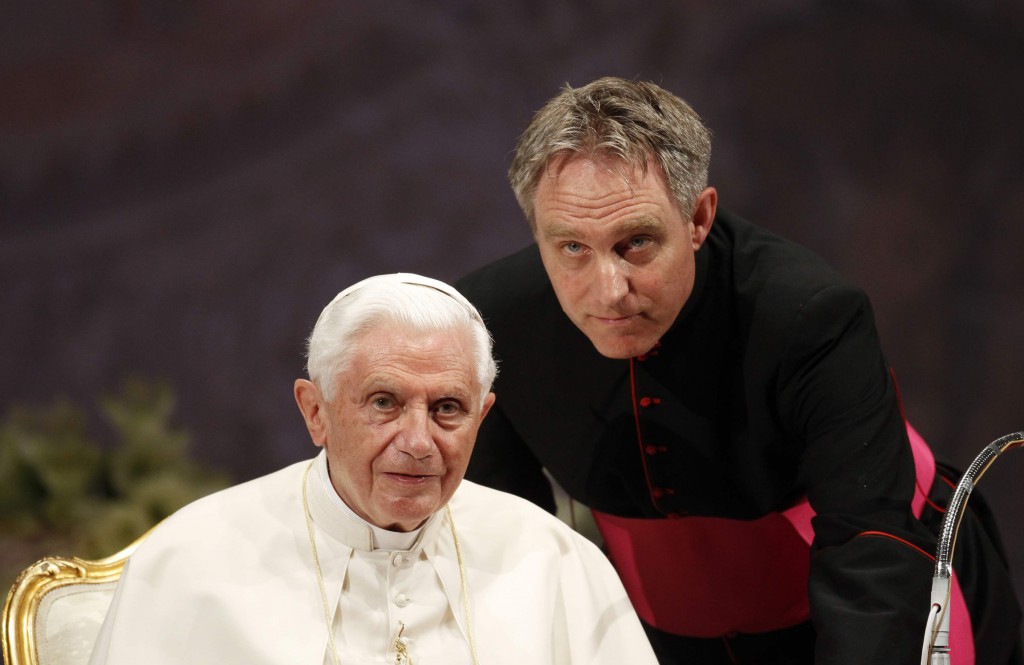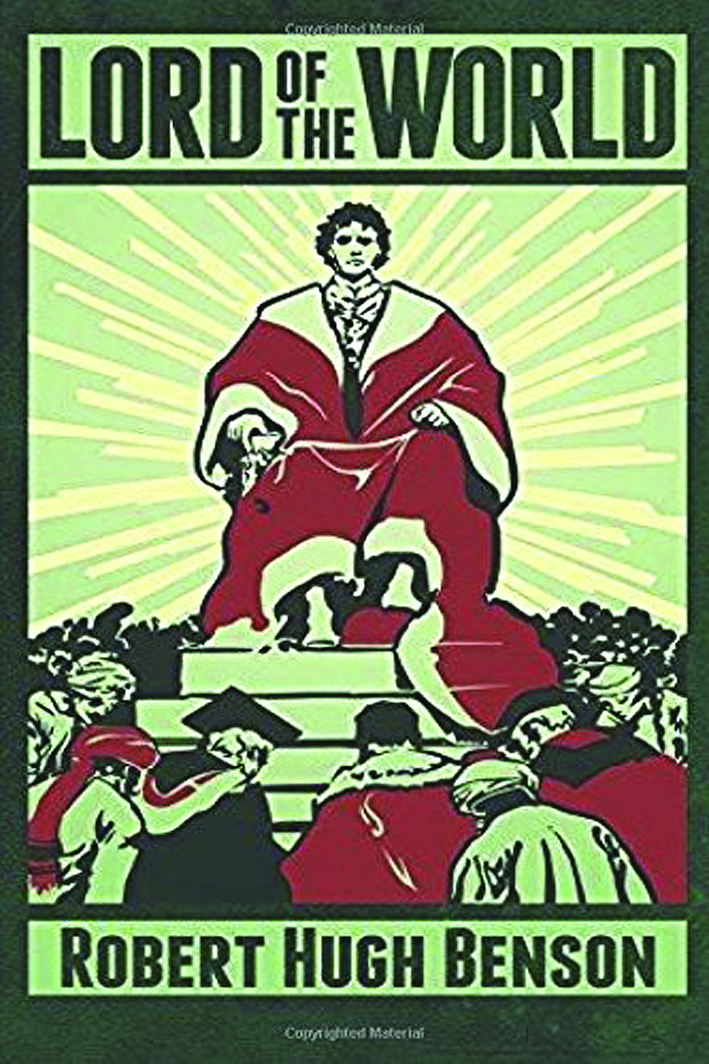Since March 1, as he himself announced, Benedict XVI has been living “hidden from the world,” and since May 2 he has been living in the Mater Ecclesiae (Mother of the Church) monastery inside the Vatican Gardens, the residence he chose, remodelled to receive him with his personal secretary and Prefect of the Pontifical Household, Archbishop Georg Gänswein, along with the consecrated women who looked after him before his resignation. Yet hidden away does not mean totally isolated. Benedict XVI leads a secluded, but not cloistered life: every now and then he receives people and friends; sometimes he celebrates Mass in the presence of a select group, as he did at the end of his former students’ summer meeting, and he was happy to attend, at his successor’s invitation, the inauguration of the monument to St. Michael the Archangel inside Vatican City on July 4. It was the presence of a silent, prayerful man at an extraordinary historic moment that sees a new Pope in office and a Pope Emeritus who stepped down from his pontificate on February 28, 2013. Even though books will soon be published on Benedict XVI’s pontificate, there are already texts expressing esteem and admiration for the German Pope and proving that the figure of Benedict XVI is still alive in the hearts of the faithful. One of these books is Benedetto XVI. Il Papa visto da personaggi famosi (Benedict XVI: The Pope Seen by Celebrities), a collection of essays by 20 personalities: Churchmen, politicians, intellectuals, economists and sportsmen, published by the Vatican Publishing House on April 16, 2012, Benedict XVI’s birthday, and edited by Archbishop Georg Gänswein, who wrote one of the 20 essays. What comes out clearly in this book, published long before the announcement of the Pope’s resignation on February 11 of this year, is the great humility of the man who, after intense activity as university professor in Germany, a brief experience as archbishop of Munich, and after serving as prefect of the Congregation for the Doctrine of the Faith for more than 20 years, succeeded John Paul II on April 19, 2005. This book, as Gänswein has written in the preface, “is not an act of deference commissioned from above. None of the authors received instructions; they were all free to express their thoughts. There was no censorship whatsoever. They all wrote what they thought and each of them took responsibility for his contribution. However, they were all anxious to do justice to Benedict XVI as much as possible and to write open-mindedly.”
Page by page, these essays, all written by authors from the German-speaking world, reveal the most important aspects of the “theologian Pope”: his humility, his great learning, his vision of the liturgy as cosmic harmony, the extraordinary sharpness of his homilies and interventions, the simplicity of his approach to people.
The stereotypical image of the “panzer Kardinal,” the “policeman of the Church” created by tendentious journalism, is miles away from the figure emerging from memory and writings. To cite but a few examples: Franz Beckenbauer, the famous soccer star of the German national team, recalls his meeting with the Holy Father in Rome in October 2005; Cardinals Joachim Meisner, Reinhold Marx (Cardinal Ratzinger’s second successor on the chair of St. Corbinian in Munich), and Kurt Koch, the author of an in-depth study of Benedict XVI’s ecumenical magisterium, write thoughtful essays; the German minister of finance, Wolfgang Schäuble, and Edmund Stoiber, president of Bavaria from 1993 to 2007, highlight Joseph Ratzinger’s Bavarian character and universal ministry (“My heart is Bavarian” but “in my mission I am a citizen of the world,” Benedict XVI said during a visit to his native region in 2006); and Notker Wolf, abbot primate of the Benedictines, highlights the link between the Pope and the monastic spirituality characterizing St. Benedict’s teachings.
As Archbishop Gänswein has written in a short but deep reflection on Joseph Ratzinger’s ministry: “The ministry of the Supreme Pontiff of the Church presents a dimension in which the personality of Joseph Ratzinger as a man and the gifts he has received find their clearest and most complete expression… As water is the same in all corners of the earth, it is nevertheless different; in fact, water has different characteristics depending on the soil through which it filters. The same applies to Popes. They carry out the same mission and answer the same call from Jesus, but each of them responds with his unique personality and sensibility. This is the indication of unity in diversity, the manifestation of what happens in Christ’s Church, where old and new proceed hand in hand in harmony and continuity.”
This is a list of ten stereotypes which have filled secular society’s discussion of the Catholic Church’s past and present since the 19th century, sometimes even within Catholic communities. These ten statements are stereotypes, truisms, sometimes legends, fakes, gross simplifications. But every now and then they are heard in drawing-room debates and conversations, on the bus or metro. Not only that, the aforesaid stereotypes are read in the newspapers, in books dealing with social and religious issues, and heard in up-to-date TV programs. In order to confute these statements incontrovertibly, or at least to rectify and speak clearly “against the current,” seven women, all of them historians though not all of them Catholic, coordinated by Lucetta Scaraffia, professor of contemporary history at the University La Sapienza of Rome and leading member in the editorial team of the L’Osservatore Romano, decided to revise some of the most common stereotypes without any apologetic intentions, but simply to set the record straight. It is from these stereotypes that hearsay originates, yet nobody deems it necessary to disprove or confute them because they have become commonplace; these stereotypes have given rise to most of the misunderstanding and incomprehension which has sometimes overshadowed historical truth. This effort has resulted in an easy to read and well-researched pamphlet entitled La Grande Meretrice (The Great Whore), published by the Vatican Publishing House; it is a book aimed at outsiders and those unable to confute these stereotypes and the countless accusations leveled at the Church.
The Great Whore, a phrase used in Chapter 17 of the Apocalypse, has become a derogatory phrase used by the Church’s detractors through the centuries, a stereotype characterizing the Church founded by Jesus Christ as a corrupt, impure and obscurantist institution. The first essay of the book is by Silvie Barny, a historian at the University of Lorraine and professor at the Institut Catholique (Catholic Institute) of Paris. She examines the opposition between the “pure Church” and the “corrupt Church” over the centuries. The second essay, by Sandra Isetta, professor of Early Christian Literature at the University of Genoa, debunks the idea that the early Christian communities were totally different from today’s organized Church. The third essay, by Lucetta Scaraffia, deals with priestly celibacy. She notes that celibacy was not imposed as a dogma, but developed from a custom in Palestine and the Hellenistic world which made a new kind of friendship possible between men and women. Also, she notes, priestly celibacy is not responsible for child sexual abuse by priests; most of the cases of pedophilia reported, she notes, occur within families.
It is once more Lucetta Scaraffia who investigates the supposed “modernity” of the Protestant world as opposed to the “backwardness” of Catholicism, highlighting the creative freedom of artists, of which Michelangelo’s frescoes in the Sistine Chapel are a case in point, and the first initiatives of social credit developed by the Franciscan Order as early as the Middle Ages. Anna Foa, professor of modern history at the University La Sapienza of Rome, writes on the Inquisition and anti-Semitism, two episodes in the Church’s long history which have been the object of misleading and disproportionate polemic attacks. Giulia Galeotti, a scholar in modern history and an editor at L’Osservatore Romano, was entrusted with the task of dispelling the stereotypes of the Church’s hostility toward science and scientists, and toward women.
Margherita Pelaja, a leading member of the Società Italiana delle Storiche (Italian Society of Female Historians), debunks the myth of the Church’s “sexophobia” and repressive attitude with an in-depth analysis of the concepts of marriage, chastity and contraception.
And Carmelite nun Cristiana Dobner presents the Christian life as a hymn to joy and beauty opposed to the stereotype of its being permeated by pain and suffering.
“The truth will set you free,” says John’s Gospel; this is what both the believer and the unprejudiced reader come to realize after reading this book of great interest, which does not pass over in silence the sins committed by Catholics, for which John Paul II asked forgiveness during the Great Jubilee of the Year 2000.



Facebook Comments